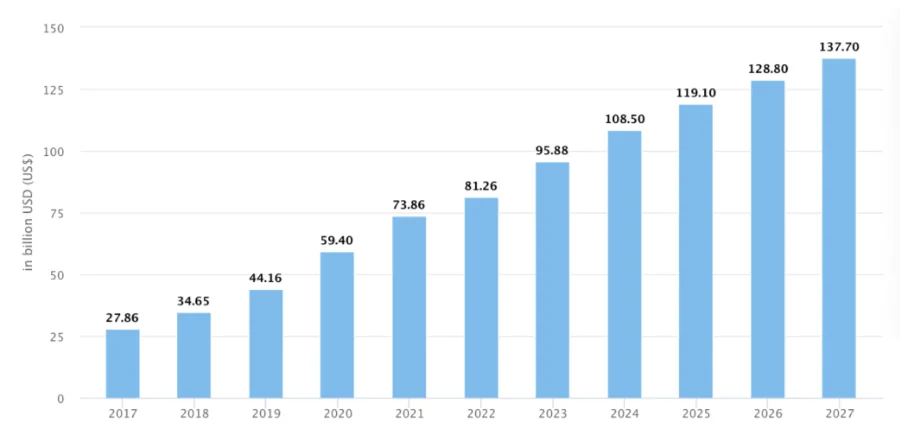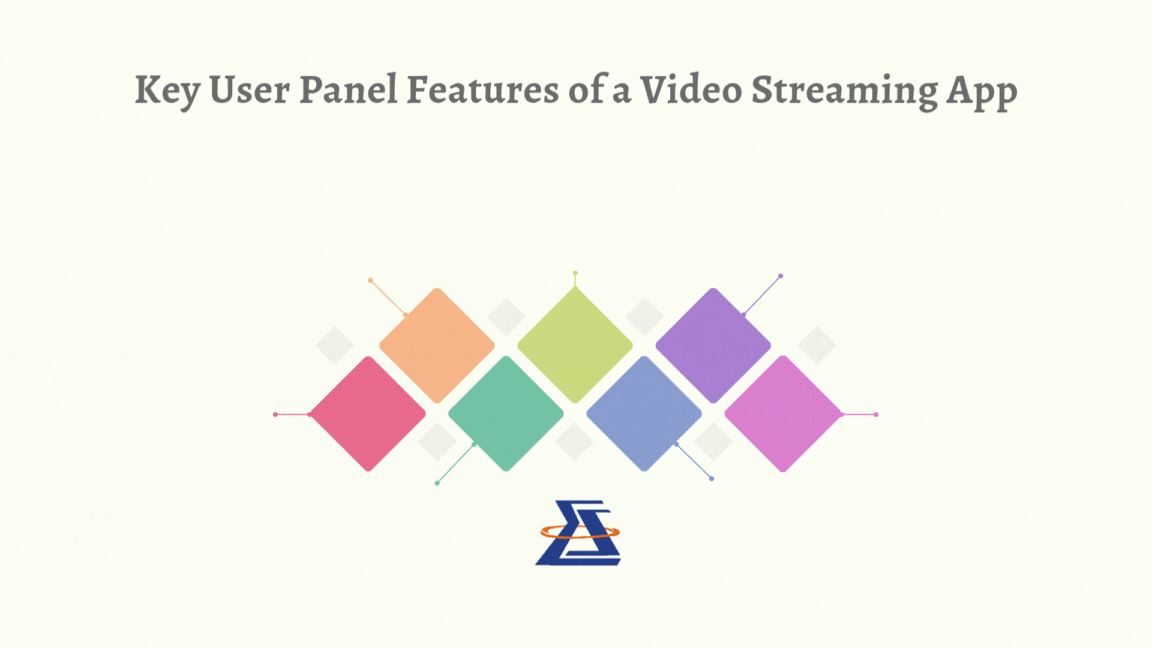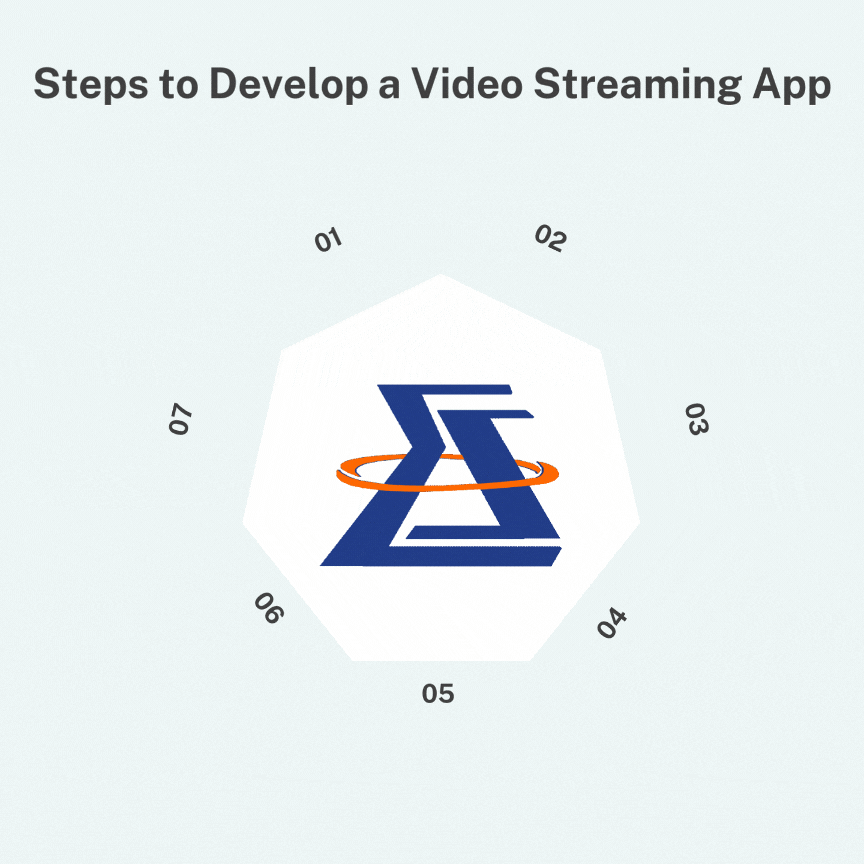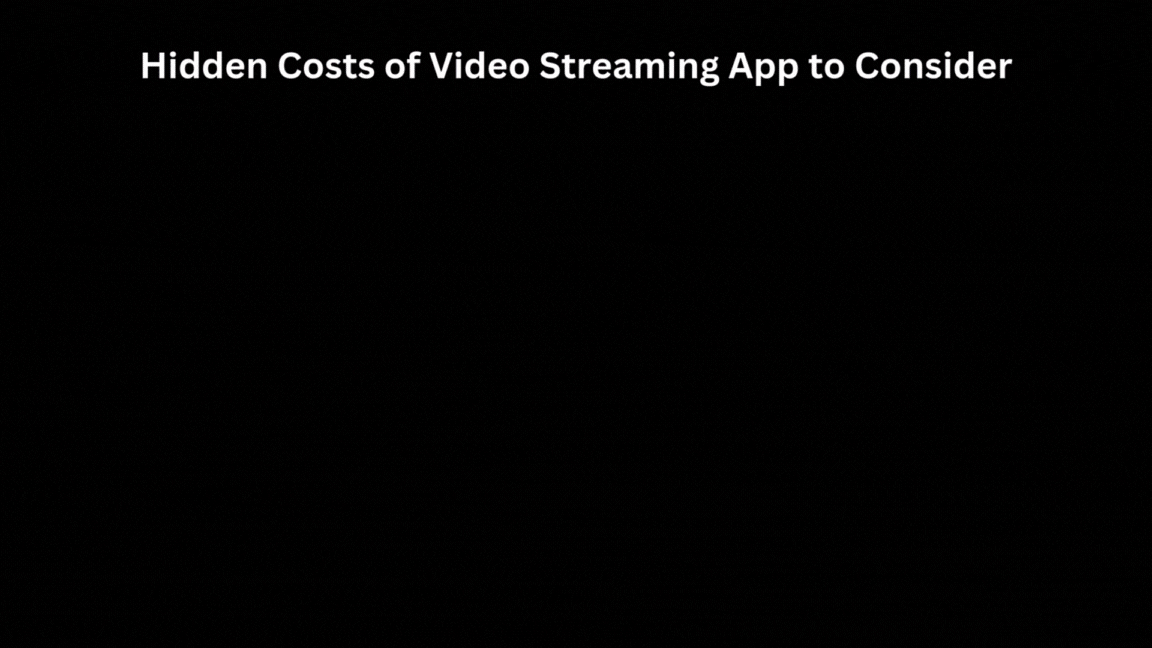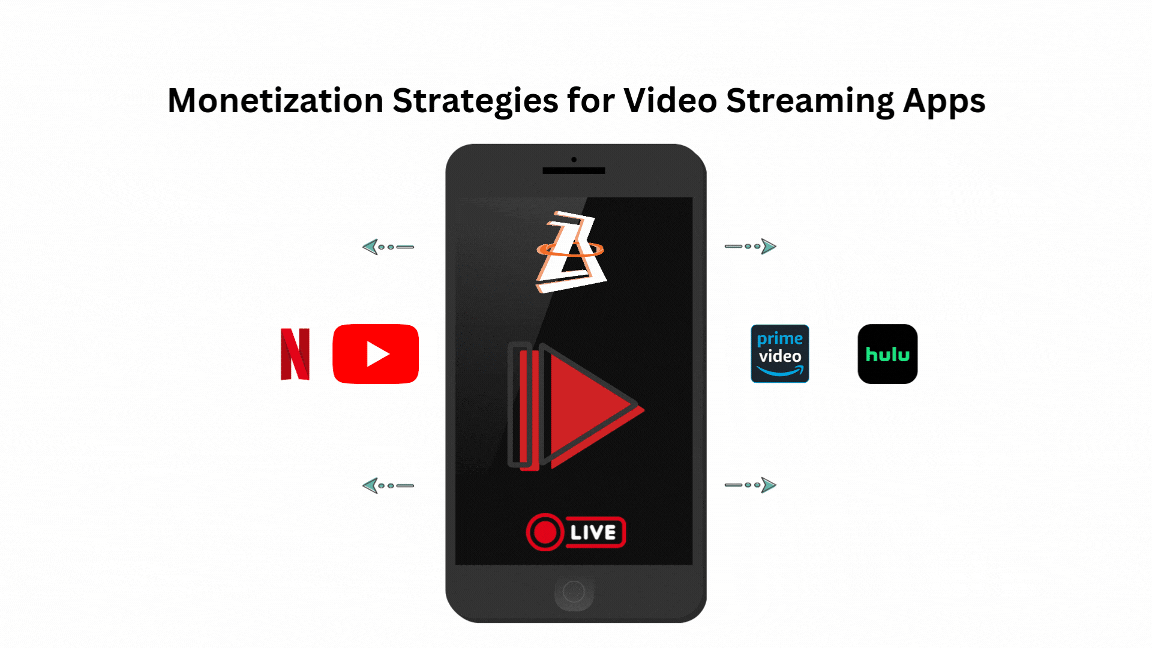Introduction
Popularity: The Streaming Revolution
Doesn’t the streaming app’s popularity surprise you? Although 2024 has seen many ups and downs in the streaming app world, where Netflix lost subscribers and revenue while many new apps made their way to the market.
According to the Statista report, the streaming app industry will grow at more than 8% annually for the next four years and may reach a market size of USD 110 billion by the end of 2024.
Image Courtesy: Statista
While watching your favorite show on your chosen streaming app, have you ever thought of what goes into video streaming app development? The surprising element is businesses worldwide are turning to streaming apps with a clear vision to provide on-demand content and improve engagement.
As a fan of streaming apps, I have always wondered: How much does it cost to build a video streaming app? We at Sigma Solve have definite answers and know how to reduce the costs to develop a video streaming app.
Despite competitive video streaming app development costs, the prospects for video streaming services are spectacularly good by 2024. The data agree with our findings.
The MNTN report quotes Disqo as suggesting that 88% of American households are now signed up for a video streaming service, up from 61% in 2019.
According to a Forbes survey, the average American watches content through 2.9 different streaming services, paying an average of $46 per month. It implies a wide choice.
Market Demand
The need for video streaming app development has risen greatly across different industries. From entertainment and educational purposes to fitness and corporate training, organizations appreciate the huge opportunities to develop on-demand video streaming apps.
Purpose of the Blog
The following is an all-inclusive guide that provides necessary insights into the cost of video streaming app development. It gives a clear schedule of costs and important considerations to enterprising people and business firms.
How Much Does It Take to Build a Video Streaming App?
The cost of developing a video streaming app depends on various factors, such as the functionalities implemented in the application and the location of a development team. In general, costs ‘per app’ are within a mid-range: if you want to develop a simple to average application, you are likely to spend between $10,000 and $50,000.
A simple app may cost as little as $10,000 and as much as $15,000, while a medium-complex application will cost between $16,000 and $25,000. Depending on the amount of multilingual support or top-notch UI/UX, it might start at $50,000 and go up to $250,000 or even more.
The cost will vary depending on certain factors, including the functionalities you want in your app. Therefore, it is recommended that you contact the relevant app development company for a quote based on your requirements.
Platform Coverage
- Android App Development: Usually an extra 20-30% of the base cost
- iOS Development: Similar cost range
- Cross-platform development: Perhaps more cost-efficient
Development Team Composition
Your development team’s composition directly impacts the video streaming app development cost:
- Project Manager
- UI/UX Designer
- Frontend Developers
- Backend Developers
- Quality Assurance Specialists
Insight
This paper outlines the various determinants of the cost of developing a video streaming app to aid businesses in making decisions about developing engaging apps.
Overview of Video Streaming Apps
Video streaming apps transform how an audience consumes content. They enable users to watch videos on demand on various devices, making a major shift in how the public is entertained, informed, and educated.
What is a Video Streaming App?
Definition
A video streaming app is a web or mobile app that streams videos on the web and offers the opportunity to watch movies, TV shows, live broadcasts, and shared content without delays on portable devices, including smartphones, tablets, PCs, and smart TVs.
Investment Perspective
This means that you should view your video streaming app as a long-term investment. While the cost of developing a video streaming platform may appear very high, the revenues are impressive. Properly managed business platforms, such as Netflix, show how proper mobile app development can be very rewarding.
Recommended Investment Strategy
It costs between $50,000 and $200,000 to develop a competitive on-demand video streaming application. These specifications enable strong features and a user experience with regard to technology that can be further scaled.
Technology Evolution
Specifically, the development ecosystem of the video streaming app will constantly change. Stay adaptable. Innovations such as Artificial Intelligence recommendations, Integrated experiences, and Personal content are no longer fancy features. On-the-job training and research education are your best riches.
Examples of Popular Video Streaming Apps
Netflix
Netflix is a giant player in the online video streaming market due to its extensive collection of produced and acquired films and serials. The recommended list without ads and the developed personal recommendation algorithm attracted more than 230 million subscribers worldwide for the development of the on-demand video streaming app.
YouTube
YouTube changed the way people shared videos because anyone could broadcast their videos. With over 250 million active participants per month, it contains comedy, educational, music, and tutorial videos, making it a diverse video app development model.
Amazon Prime Video
As part of Amazon, Prime Video provides added value, combining the benefits of streaming services with the disadvantages of e-commerce client purchases. It has been offering original content, which has triggered the common use of Prime membership to access the video streaming service.
Types of Video Streaming Apps
On-Demand Video Streaming
Services like Netflix and Amazon Prime let users view programs recorded ahead of time at any time. These apps contain an enormous amount of movies, TV shows, documentaries, and other content, making it possible to create individual viewing.
Live Streaming Apps
Examples of such services are Twitch and Facebook Live, which allow for real-time video streaming. People can broadcast gaming sessions, happenings, concerts, and other events from their lives, generating real-time, engaging content for fans all over the world.
Video Sharing Platforms
YouTube and TikTok are Social media platforms on which users generate short and even long videos to upload to the site. These apps make content creation more accessible, allowing anyone to be a publisher and share it with millions.
Industry-Specific Apps
Niche streaming applications are meant for particular niches, including organizational training, coursework, health and physical fitness, and continued personal development. These platforms provide faculty and students with content delivery tailored to skills development, professional training and advancement, and niche market learning.
Comparative Analysis of Video Streaming App Types
| App Type | Primary Purpose | Content Style | User Interaction | Typical Examples | Cost to Build |
|---|---|---|---|---|---|
| On- Demand | Entertainment & Learning | Pre- recorded | Passive Consumption | Netflix, Hulu | Medium-High |
| Live Streaming | Real-time Engagement | Immediate/Unedited | Interactive | Twitch, Facebook Live | High |
| Video Sharing | Content Creation | User-Generated | Highly Interactive | YouTube, TikTok | Medium |
| Industry-Specific | Professional Development | Targeted Learning | Structured Interaction | Coursera, Corporate Training Platforms | Web apps, SaaS, storage |
Evaluate
When considering the costs to build a video streaming app, businesses must evaluate the following:
- Target audience
- Content strategy
- Technical infrastructure
- Monetization model
- Platform compatibility
The development cost of a video streaming app relies on the mentioned factors, ranging from $30,000 for essential platforms to $250,000 for sophisticated applications.
Strategic Considerations
For entrepreneurs exploring video streaming app development, consider the following:
- Unique value proposition
- Target market needs
- Scalable technology stack
- Content acquisition strategy
- User experience design
Exploring these detailed features of video streaming app development will enable organizations to provide consumers with inviting applications that can actively capture their attention.
Key Features of a Video Streaming App
Appropriate to the paradigm of digital entertainment, a successful video streaming app is entertaining, convenient, and easy to use, attracting an audience. Understanding the critical features is important in creating a great video streaming app.
User Panel Features
Account Creation and User Profile Management
A user profile is an entrance to the world of personalized services or products. They enable Login, help retain preferences, display the history of viewing, and make a journey more personalized, which also helps increase user experience and user loyalty while developing video streaming apps.
Search Functionality with Advanced Filters
State-of-the-art navigation tools revolutionize content finding. Through filter facilities, users can easily search a certain number of categories, genres, release years, and ratings, making content consumption fun and easy.
Video Library with Personalized Recommendations
The intelligent recommendation system is the main driver of most streaming solutions today. These systems uniquely recommend content that users have viewed, liked, and engaged with to keep them entertained and more engaged with the platform.
Watchlist Creation and Video Bookmarking
One feature of the proposed systems is that watchlists enable users to compile their content libraries. When interesting videos are selected for later, each user has a queue that can improve overall streaming and boost user engagement with the platform.
Multi-Language Support and Subtitles
The availability of videos to users all over the world greatly influences the development of streaming applications. Ensuring that people can read content in their preferred language and that there are enough subtitle options for any platform makes them accessible worldwide.
Offline Download and Playback
Streaming apps allow users to watch content offline, which is helpful for those who may rarely have access to the Internet. By allowing video downloads, streaming apps also meet the needs of travelers, commuters, and individuals in regions with unstable internet connections.
Social Sharing and Community Engagement Tools
Social features allow users to share favorite content, discuss productions, and build a social base. These tools turn television viewership into an interactive social place, enhancing user engagement.
Admin Panel Features
Content Management System (CMS)
A practical and strong CMS must support the organization of uploaded videos and manage metadata. This back-end tool should be handy for keeping the library of content updated and organized.
User Analytics and Engagement Tracking
Metrics supply information about users’ activity, content consumption, and level of interaction with publishers and advertisers. These metrics assist streaming services in improving content approaches and customer experiences.
Subscription and Payment Management
Variations in the type of subscription plans and sound forms of payment for services are also important. They also allow users to be easily onboarded, provide ways of granting differential access levels, and provide easy billing processes for different payment options.
Push Notification Control
Positive notifications keep the audience interested in new materials, individual suggestions, and application updates. Thus, they improve users’ engagement without being intrusive.
Advanced Reporting and Revenue Analytics
Reporting tools enable organizations to analyze their financial progress, evaluate revenue models, and make strategic decisions about content acquisition and platform creation.
Advanced Features (Optional but Impactful)
AI-Driven Recommendation Engine
Rather than that, the world, enhanced by intelligent AI algorithms, identifies various factors connected with the user to create content recommendations based on information and astronomy, which highly help to improve satisfaction and loyalty to the platform.
Live Streaming Integration
Additional features that can be added include live streaming, which enhances the ability to broadcast content in real-time, such as during events, gaming, educational sessions, and even interactive sessions.
Multi-Screen Support
Freedom of access on a range of devices makes it possible for users to access content on smartphones, tablets, smart TVs, and computers.
Parental Controls
The high functionality of parental control will help people configure comfortable conditions for watching videos and protect children from undesirable, time-consuming genres.
Video Quality Optimization
ABR control adjusts the video stream throughput depending on the bandwidth available on a particular channel, thereby allowing constant streaming with the least buffering, even under dissimilar networks.
Integration with AR/VR Technologies
Pathbreaking technologies such as AR and VR create content consumption experiences from streaming platforms as cutting-edge products in the television and film industry.
Insight
This way, businesses can develop features that users find appealing and invest an adequate amount of money to create a positive value proposition for an appealing video streaming platform in a highly competitive field.
Steps to Develop a Video Streaming App
Creating a video streaming application is a long process that involves several key steps, analysis, strategies, and skills. This guide outlines some of the most critical aspects of video streaming app setup to give you insight into what it takes to establish a working video streaming digital business.
Step 1: Market Research and Competitor Analysis
Importance of Understanding Target Audience Needs
Market research is one key component of developing a good video streaming application. When app creators understand deeply what users want and do not like about a product and what they would like to see next, they can innovate to target unique audiences and make the application stand out from similar ones.
Identify Gaps in the Market and Features Users Desire
Carrying out a market analysis, in this case, shows that there is still room for growth. Innovations in this area that can eliminate existing flaws in platforms today greatly reduce the overall costs to develop a video streaming app and increase the potential customer base.
Step 2: Define Your App’s Purpose and Monetization Model
Choosing the right monetization model is a significant aspect of determining the monetary viability of your video streaming app development initiative.
Subscription-Based (SVOD)
SVOD is a service that allows people to watch television content as many times as they want with a fixed monthly fee that they pay. These long-tail business models have become incredibly common in today’s world, as shown by companies like Netflix, which offer stable and long-term client revenue.
Advertising-Supported (AVOD)
Advertising-supported models enable clients to access free, quality content while the firms generate revenues through advertising. First, they can decrease the cost of installing a video streaming platform while producing earnings from specific ads.
Pay-Per-View (TVOD)
Transactional Video on Demand (TVOD) enables users to pay for content one at a time. It is particularly suitable for paid or scarce intrinsic content where time is under less pressure, as both the users and the sources benefit from the freedom acquired in the accounts.
Freemium Models
Freemium strategies provide basic features for free; however, they also include complex but the best video streaming app features that users must pay for. This approach may attract more users and generate multiple income sources.
Step 3: Wireframing and UI/UX Design
Importance of Intuitive and Attractive Designs
This paper also highlighted the importance of the user interface in the design of video apps. A sophisticated and clear layout is a decisive factor in enhancing the primary goal of user engagement during such a perplexing task of finding content.
Design Tools
Modern UI design tools such as Figma, Adobe XD, and Sketch help the developer lay out the interface with interactive prototypes from early conception to the development phase.
Step 4: Back-end and Front-end Development
Back-end Technologies
When designing an efficient and scalable on-demand video streaming app development infrastructure, it is important to choose the proper back-end technologies, such as Node.js, Python, Ruby on Rails, or others.
Video Hosting Platforms
AWS and Google Cloud help build the foundation for robust, worldwide content storage and streaming.
Front-end Frameworks
Today’s front-end frameworks, such as React and Flutter, allow application development for multiple platforms, reducing the total cost of developing the live-streaming app so that the user interface will be similar.
Step 5: Video Encoding and Content Delivery
Encoding for Different Devices
Video encoding helps establish how the content will flow on different devices and under different networks. This crucial step involves transcoding video files into several formats with different qualities.
Content Delivery Network (CDN) Integration
CDN integration needs to be implemented in streaming processes to make all the difference. It provides content across international servers to eliminate the delay issue affecting consumers.
Step 6: Testing and Quality Assurance (QA)
Comprehensive Testing Approaches
Rigorous testing ensures app reliability through:
- Functional testing to verify feature performance
- Performance testing to assess speed and stability
- Cybersecurity testing to prevent data breaches and vulnerabilities
Step 7: Launch and Ongoing Maintenance
Multi-Platform Release
Releasing it on iOS, Android, and web platforms is the optimal way to engage users to the maximum. Specific optimization or selling occurs on each platform and follows its guidelines.
Continuous Improvement
Regular updates are crucial for:
- Adding new features
- Improving performance
- Addressing user feedback
- Maintaining security
Insight
Suppose a development team follows these strategic steps and comprehends the intricate notion of processes to reduce the live streaming app development costs, being an entrepreneur. In that case, you can build gripping applications with captivating UX/UI solutions.
Cost Breakdown of Video Streaming App Development
Understanding multiple key cost aspects will help when examining the financial characteristics of developing a video streaming application. This section will disintegrate more detailed cost factors that affect the total capital investment in developing a digital streaming platform.
Development Costs by Region
| Region | Basic App | Mid-Level App | Advanced App |
|---|---|---|---|
| United States | $100-150/hr | $150-250/hr | $250-350/hr |
| Canada | $90-140/hr | $140-230/hr | $230-330/hr |
| Germany | $80-120/hr | $120-200/hr | $200-300/hr |
| Poland | $40-70/hr | $70-110/hr | $110-180/hr |
| Russia | $30-60/hr | $60-100/hr | $100-150/hr |
| India | $20-40/hr | $40-80/hr | $80-120/hr |
| China | $30-50/hr | $50-90/hr | $90-150/hr |
| Australia | $80-130/hr | $130-220/hr | $220-320/hr |
| Brazil | $30-60/hr | $60-100/hr | $100-180/hr |
Factors Affecting Development Costs
App Complexity
It is vital and widely appreciated that the more complex an app, the higher its development costs. Simple applications with basic facilities are cheaper than advanced technology, which will yield many fruits.
Types of complexity:
- Basic: Simple streaming with minimal features – USD 10,000 to 60,000
- Medium: Advanced search, personalization – USD 70,000 to 120,000
- Complex: AI-driven, multi-platform support – USD 125,000 to 250,000+
Platform Choice
The choice of platform has an enormous impact on video streaming platform development costs. Options include:
- Native iOS development
- Native Android development
- Cross-platform solutions
- Web-based applications
Both approaches have their strengths and weaknesses, as well as different costs pertaining to mobile app development.
Features and Advanced Integrations
The complexity of features increases the development cost, and the more features, the higher the costs. Enhancements such as an artificial intelligence recommendation system, real-time analysis, and customized content search can increase the difficulty level and total cost of developing a video streaming platform.
Back-end Infrastructure
A strong back-end has been established to support video streaming services since it is undesirable to get a lamentable flow, image, or picture on the Internet. Costs include:
- Cloud server expenses
- Content Delivery Network (CDN) integration
- Database management
- Scalability solutions
Cost Estimates for Development
| Region | Basic App | Mid-Level App | Advanced App |
|---|---|---|---|
| United States | $30,000-$50,000 | $50,000-$150,000 | $150,000-$250,000 |
| Canada | $25,000-$45,000 | $45,000-$140,000 | $140,000-$230,000 |
| Germany | $25,000-$40,000 | $40,000-$120,000 | $120,000-$200,000 |
| Poland | $15,000-$30,000 | $30,000-$80,000 | $80,000-$150,000 |
| Russia | $10,000-$25,000 | $25,000-$70,000 | $70,000-$130,000 |
| India | $8,000-$20,000 | $20,000-$50,000 | $50,000-$100,000 |
| China | $10,000-$25,000 | $25,000-$60,000 | $60,000-$120,000 |
| Australia | $25,000-$45,000 | $45,000-$130,000 | $130,000-$220,000 |
| Brazil | $12,000-$30,000 | $30,000-$80,000 | $80,000-$160,000 |
Hidden Costs to Consider
App Hosting and Server Costs
It is crucial to admit that monthly hosting expenses for web-based video streaming services can vary between $500 and $5,000, depending on the number of users and the volume of content.
Licensing Fees for Premium Content
Content acquisition is one of the most enormous costs, with a minimum of $10,000 to a maximum of $100,000 per year, depending on the platforms’ content approach.
Maintenance and Regular Updates
These activities can cost 15% to 20% of the initial development budget, and it is critical to keep the application competitive and aligned with current technology.
Marketing and User Acquisition
Creating a new on-demand video streaming app requires a marketing budget that can amount to between $5,000 and $50,000 in the first months of marketing.
Cost Estimation by Development Approach
Freelance Developers
- Lower cost: $15,000 $50,000
- Variable quality
- Limited support
Local App Development Agency
- Mid-range cost: $50,000-$150,000
- Better quality control
- More comprehensive services
Offshore Development Companies
- Competitive pricing: $20,000 $100,000
- Cost-effective
- Potential communication challenges
Recommended Steps for Cost-Effective Development
- Define a clear project scope.
- Choose the right technology stack.
- Prioritize essential features.
- Plan for future scalability
- Select the right development partner.
Monetization Strategies for Video Streaming Apps
When your video streaming app is only a great idea, you need to think of how to turn it into a moneymaker. Therefore, any sustainable video streaming app and any business must learn different types of revenue models to realize the maximum amount of income through the operation of the business’s platform.
Detailed Explanation of Revenue Models
Subscription Model (Netflix-Style)
A monthly access fee delivers limitless consolidated content. It provides a fairly reliable form of revenue, fosters extended user retention, and opens a variety of pricing models that lower the cost of an app for streaming videos. Thus, it effectively provides stable income and enables effective app development.
Advertising Model (YouTube-Inspired)
Advertising-supported platforms earn revenue by promoting distinctive advertisements alongside content. This model gives users full access, and developers can generate multiple sources of revenue, such as video ads, sponsorships, and partnerships. These can help recover the initial cost of developing a video streaming app.
Pay-Per-View Model
Pay-per-view strategies allow users to charge for specific content that is appropriate for premium events, newly released movies, or any educational material. This model offers users versatility and can develop valuable revenue streams for content particularizers.
Freemium with In-App Purchases
Freemium business models can provide basic material for free and cost-for-paid attributes, further feeds, or better ways to watch. Thus, the focus on a more extensive variety of users and the swifter development of the work’s multiple revenue sources make this approach indispensable for the creation of on-demand video streaming apps.
Choosing the Right Monetization Model
Strategic tips for selecting an optimal monetization approach:
- Perform all this market analysis to ensure that you get acquainted with your target market, including spending habits and content consumption.
- Evaluate the current tactics that rivals use to set prices and generate income in order to define the possibilities in the market.
- You should think about information in your content library as a provider and potential values for users.
- What are the technical requirements and costs of the model you chose for creating a video streaming platform?
- Calculate potential user acquisition cost and expected lifecycle customer value for every monetization option.
- Stay agile and be ready to adapt, switch, or use more than one of the revenue ideas mentioned as your platform develops.
Comparative Revenue Potential
| Monetization Model | Pros | Cons | Best For |
|---|---|---|---|
| Subscription | Predictable revenue | High initial user resistance | Extensive content libraries |
| Advertising | Low barrier to entry | Potential user frustration | Broad, diverse content |
| Pay-Per-View | High-value content monetization | Limited recurring revenue | Exclusive or premium content |
| Freemium | Broad user acquisition | Complex conversion strategy | Platforms with tiered content |
Further Factors Essential for Building a Video Streaming App
When planning your monetization strategy, consider these critical factors:
Content Acquisition Costs
Gaining good content is costly, as it means gaining a lot but giving little back to the content creators. Your selected model must incorporate content licensing and creation costs.
Technical Infrastructure
Different monetization strategies require different degrees of integration, and this determines the cost of creating a video streaming application.
User Experience
This implies that one must be careful not to develop a monetization strategy that hinders user convenience or interferes with content access in any way.
Challenges in Developing a Video Streaming App
The process of developing a video streaming app is multifaceted due to the various technological problems, legal issues, and competition issues to consider. Anyone who wants to develop an appropriate digital platform to fund a start-up should recognize these common challenges while trying to grow market share in a densely competitive environment.
Content Licensing and Copyright Issues
Content licensing is one of the most significant hurdles in creating video streaming applications, and the global market appears highly complex. Pursuing legal rights to stream content requires protracted and complicated discussions, significant capital expenditure, and constant adherence to the laws on copyrights internationally.
Key challenges include:
- Negotiating expensive licensing agreements
- Managing regional content restrictions
- Ensuring continuous legal compliance
- Tracking and renewing content rights
- Preventing unauthorized content distribution
The actual cost of creating a video streaming app can skyrocket due to content acquisition costs, which can range from $50k to $500k per annum, depending on the size of the library and the number of exclusive rights obtained.
Ensuring Scalability and High Performance During Peak Usage
Technical infrastructure is not necessary when creating on-demand video streaming applications. Your platform must support immense user concurrency and simultaneously feed customers’ accounts with high-quality material.
Performance challenges include:
- Managing server infrastructure
- Implementing robust Content Delivery Networks (CDNs)
- Developing adaptive streaming technologies
- Preventing buffering during high-traffic periods
- Maintaining consistent video quality across devices
Many types of infrastructure can help reduce the costs of building a video streaming app, and the best types of scalability can add 20-30% to the overall development costs.
Data Security and User Privacy Compliance
The privacy of user data is now considered critical when designing modern video apps. SVoD services gather a lot of personal and viewing history information that must be protected and conform to regulations worldwide.
Critical security considerations:
- Implementing advanced encryption protocols
- Securing payment information
- Protecting user authentication systems
- Complying with GDPR, CCPA, and other privacy laws
- Preventing potential data breaches
Appropriate security measures add development costs but positively influence the users’ perception and legal aspects.
Competing with Existing Industry Giants
Entering the crowded video streaming sector—currently virtually monopolized by the three giants—Netflix, Hulu, and YouTube—is not easy. It requires new strategies and propositions that differentiate the new entrant from the giants. Successful small and medium platforms either provide more specialized content, offer a better user experience, or target a much more specific audience.
Competitive strategies include:
- Developing unique content libraries
- Creating personalized recommendation algorithms
- Offering competitive pricing models
- Targeting underserved audience segments
- Investing in cutting-edge user interface design
Managing App Maintenance and Content Updates
Constant change is expected, especially for companies involved in video streaming platforms. Subsequent releases, literal patches, and feature updates are inevitable to maintain users’ interest and comply with the rapid advancement of technologies.
Maintenance challenges encompass:
- Regular software updates
- Compatibility with new device technologies
- Integrating user feedback
- Expanding content libraries
- Implementing new monetization features
The recurrent operating cost is usually 15–25% of the one-time cost of building a video streaming app. This is necessary to keep the platform afloat and maintain the highest level of technological innovation.
Maximizing Value: Strategic Tips for Reducing Video Streaming App Development Cost
Creating a video streaming application is costly. However, several techniques can help any intelligent business person reduce their development expenses while ensuring a highly presentable product. Now, let’s look at reasonable strategies that can help you decrease the amount invested by half.
Leverage MVP (Minimum Viable Product) to Launch Quickly
Several strategies can help effectively manage the costs of video streaming app development. The first one is to create a Minimum Viable Product (MVP). By releasing a stripped-down version with the essentials, you can pilot it, see if there is strong demand, hear from customers, and grow it over time. This is a cost-effective way to begin development since most of the monetary risks are minimized at the initial stage.
Outsource Development to Cost-Effective Regions
The cost of developing video streaming applications can also be easily reduced due to outsourcing in areas where the cost of labor is low. India, Ukraine, and Vietnam are the hot favorites for outsourcing as they come with reasonable rates but comic skills developers. Doing so can reduce development costs by 40-60 percent while concurrently delivering excellent mobile app development.
Utilize Third-Party Services for Video Hosting and Analytics
Adopting the available video hosting and video analytics platform will significantly reduce the costs to develop a video streaming app. There is possibly a pool of scalable platforms available, such as Firebase, AWS, Google Cloud, etc. Do not invest time and money in developing complex systems used in your projects; instead, take advantage of such services.
Adopt Open-Source Frameworks and Tools
Open-source technologies considerably lower the price of creating a video streaming application; reliable technologies are React Native, Flutter, and Node.js. They facilitate Android application development and allow start-ups to build credible streaming services with minimum stakes needed.
Case Studies of Successful Video Streaming Apps
There are many examples of successful video streaming app development. Studying these pioneers should help us understand the possible issues related to building a competitive platform. It is time to find out how leading industry participants approached the process of constructing video streaming applications.
Netflix: Journey from DVD Rentals to Global Streaming Leader
Netflix transformed from a DVD rental company into a global streaming platform. Huge investments in technology and content enabled Netflix to permanently change how people engage with entertainment, demonstrating that cutting-edge video streaming app development can redefine entire industries.
Disney+: Rapid Rise in Subscriptions and Market Impact
Disney+ is one of the best examples of how a good brand and targeted content approach work. In several months, their video streaming app development approach has received millions of subscriptions, proving that focusing on customers is the main strategy for success.
Twitch: Dominating the Live Streaming Industry
Twitch changed live streaming by providing content directly of interest to gaming audiences. Their novel strategy in video streaming app development led to a platform that fosters interaction between creators and audiences, thus exposing the role of specialized attributes.
Takeaways for New Developers
Therefore, upcoming developers must get an idea of the costs of building a video streaming app. Collecting knowledge and data on target users and developing technologies that can be adapted for volume production is fundamental to creating a diverse and immersive mobile streaming application.
Conclusion: Understanding Video Streaming App Development
Watching the evolution of video streaming apps reveals some intricate processes. We examined how Netflix, Disney+, and Twitch redesigned the entertainment space. Depending on the features, app complexity, and development methodology, video streaming app development costs stand anywhere from $20,000 to $200,000. Realizing these aspects is essential for prospective business people.
Growing Opportunities in Video Streaming
The growth of the video streaming app development market is in its infancy and teeming with possibilities. People worldwide want targeted, affordable content, and with AI and 5G, the possibilities are virtually limitless. Great developers can use many small but profitable market segments to change how people consume media on the planet.
Professional Consultation is Key
The cost of building a video streaming app requires the expertise of a qualified individual. Professional developers provide specifically developed services that meet your expectations and your pocket. That is why they help determine the correct approaches to developing a video streaming app to guarantee the technical and financial success of your project.
Ready to make your dream of a video streaming application come true? As a video streaming app development company in the US, we boast professional on-demand video streaming app developers and designers. Get in touch with us today for your free consultation and unleash your platform’s remarkable capabilities!
Final Thoughts
The cost to develop a video streaming app is not just about finances—it’s about bringing people together through meaningful content. Regardless of the type of video content you’re aiming for—live streaming, video on demand, or even a specific audience—you will see success if you are passionate about your project and have a solid plan in place.
FAQs: Understanding Video Streaming App Development Costs
According to research, the cost of developing a live-streaming app ranges between $30,000 and $100,000. This rise dramatically depends on factors such as real-time streaming technology, user interface, and app back-end, which all determine the general cost of video streaming app development.
Building an on-demand video streaming app costs $40,000-$150,000, depending on factors such as the cost of content management systems, user experience design, and the integration of enhanced features.
For instance, setting up a wide video streaming network like Netflix may take anything between $100,000 and $500,000. Such is a rich and diverse recommendation engine, a vast choice of available content, and cross-platform compatibility.
The development of a multi-language video streaming application will cost between $50,000 and $200,000. Other expenses are translation services, localization features, and support of multiple content libraries.
The cost of more sophisticated alternative feature video streaming applications is $75,000 to $250,000. Tools we can consider advanced opportunities, such as recommendations with AI capabilities, personalized content, ad hoc viewing, and analytics, lead to higher development costs.
A website with the same business model as YouTube, sharing videos, would cost between $100,000 and $300,000. Additional functionalities, such as editors, advertising facilities, and other options that allow users to create content, monetize it, and work with it sophisticatedly, entail expenses.
The cost of creating apps that enable video streaming through artificial intelligence can range from $80,000 to $300,000. Three key factors primarily determine whether to include or exclude live streaming in an application: machine learning algorithms, individual recommendations, and smart content personalization. These factors introduce high variability in the cost of the live-streaming app.
Videos that allow for live chat usually cost between $50,000 and $150,000. The general cost of creating a video streaming application varies from application to application, and real-time communication features, moderation tools, and integration complexity all affect the cost.
